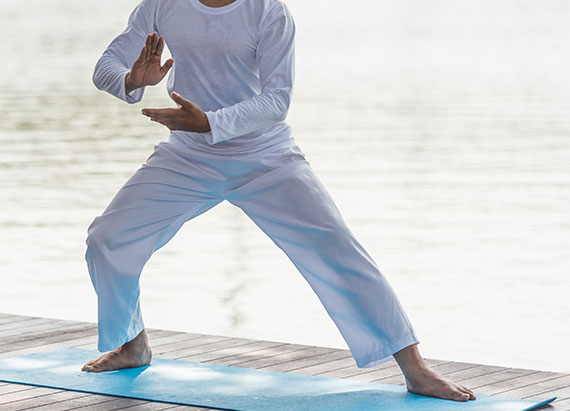
When the Western world thinks of “martial arts,” it inevitably thinks of kicking, punching, fighting, and body contact. Not slow, rhythmic, and meditative body movements designed to enhance relaxation, inner calm, and peace. But that’s what the martial art of tai chi is all about: slow, rhythmic, meditative movements designed to help you find peace and calm. In this article, we will cover the history, philosophy, and benefits of tai chi, as well as how and where to get started, and more.
Tai chi is a centuries-old Chinese martial art that descends from qigong, an ancient Chinese discipline that has its roots in traditional Chinese medicine. (The people that you see moving gracefully with flowing motions in parks throughout China, and increasingly throughout much of the modern world, are practicing tai chi.) According to some records, tai chi dates back as far as 2,500 years! It involves a series of slow, meditative body movements that were originally designed for self-defense and to promote inner peace and calm.

According to the tai chi historian Marvin Smalheiser, some tai chi masters are famous for being able to throw an attacker effortlessly to the floor with the attacker and spectators unable to clearly see how it was done. Their movements use internal energy and movements too subtle for most people to observe, reflected in the notion that “four ounces can deflect a thousand pounds.” At this high level of skill, a defender can use a small amount of energy to neutralize the far greater external force of an attacker.
In traditional Chinese medicine, human beings are considered miniature versions of the universe, and like the universe, they are thought to be made up of the constant interaction of five elements (metal, water, fire, wood, and earth). It is believed that these five elements flow in an interrelated manner throughout all the organs of the body as the five phases of universal qi (pronounced “chee”), with qi defined as the life force – the intrinsic energy in the body that travels along pathways in the body called meridians. A state of good health is achieved when the interactions between these elements cause the flow of your qi to occur in a smooth and balanced manner. You could say that one reason you study tai chi is to help your qi flow smoothly.
Qigong, from which tai chi (qi) originates, is a discipline that involves the mind, breath, and movement to create a calm, natural balance of energy that can be used in work, recreation or self-defense. Like yoga, where many varieties have evolved over the centuries, there are more than 3,000 varieties of qigong and five major traditions: Taoist, Buddhist, Confucian, martial arts, and medical, and two major types: “soft” and “hard.” Soft qigong is called inner qigong, of which tai chi is an example.
Yang, wu, and tai chi chih are three of the most popular styles of tai chi. The yang style, which includes 24 movements in its simple form (108 movements in the traditional form), is demanding because you must keep your stance wide and your knees bent most of the time. The wu style, which includes 24 to 36 movements in its shorter form (100 movements in the traditional), is gentler than the yang style because it uses a narrower, but higher stance where the knees are not quite as bent. The tai chi chih style, which has 20 movements, also uses a higher stance, but with much less transfer of weight from one leg to the other than the other two. Because the wu style uses a high, narrow stance, it may be easier for beginners and ideal for improving balance. No matter which style you practice, they all are conducted slowly, deliberately, and gracefully, with each movement flowing seamlessly into the next without hesitation.